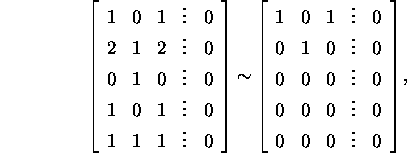Let us consider an ![]() matrix
matrix

with real elements. The matrix A can be expressed both by the column-vectors
![]() =
1 : n) of A or by the row-vectors
=
1 : n) of A or by the row-vectors ![]() =1
: m) by the transpose of A
=1
: m) by the transpose of A

where ![]() and
and ![]() and
and 
Definition 2.4.1.
The subspace ![]() of the set
of the set ![]() of column-vectors of the matrix A is called the subspace of column-vectors
of the matrix A, and denoted by
of column-vectors of the matrix A is called the subspace of column-vectors
of the matrix A, and denoted by ![]() or ran(A).
or ran(A).
Definition 2.4.2.
The subspace ![]() of the set
of the set ![]() of the row-vectors of the matrix A is called the subspace of
row-vectors of the matrix A, and denoted by
of the row-vectors of the matrix A is called the subspace of
row-vectors of the matrix A, and denoted by ![]() or ran(AT).
or ran(AT).
Definition 2.4.3. The rank of the matrix A is the greatest natural number k, for which there exist a minor of order k different from zero. We denote the rank of A by rank(A).
Let rank(A)=r. Due to the theorem about the rank of the matrix, we get
Proposition 2.4.1.
The rank of the matrix is equal to the dimension of
the subspace of its row-vectors or column-vectors,
i.e.,
![]()
Definition 2.4.4. The (right)
null space of the matrix A is the set of all solutions

of the system of equations
![]()
It is a subspace,
denoted ![]() or null(A).
or null(A).
Proposition 2.4.2.
For every matrix ![]() with the rank r, it holds
with the rank r, it holds
![]()
Proof. The matrix of the system has the rank
r, and the number of variables in (4) equals n. Therefore,
the number of degrees of freedom of the system is n-r. The
number of degrees of freedom gives the dimension of the null
space. Thus, ![]() We can rewrite the system (4) in form
We can rewrite the system (4) in form

Therefore, ![]()
![]()
![]() =
1 : m), i.e., the row-vectors of A are orthogonal to any vector
of the null space
=
1 : m), i.e., the row-vectors of A are orthogonal to any vector
of the null space ![]() of the matrix A. Hence
of the matrix A. Hence ![]() As, in addition,
As, in addition, ![]() and
and ![]()
![]() and the space
and the space ![]() can be expressed by direct sum
can be expressed by direct sum
![]()
Definition 2.4.5. The
(left) null space of the matrix A is the set of all solutions

of the system of equations
![]()
This subspace is denoted by ![]() or null(AT).
or null(AT).
Proposition 2.4.3.
For every matrix ![]() with the rank r, it holds
with the rank r, it holds
![]()
Proof. The matrix of the system AT
has the rank r, and, the number of variables
in (5) equals m. Therefore, the number of degrees of freedom of
the system is m-r and
![]()
The system (5) can be expressed in form

So ![]()
![]() =
1 : m) and
=
1 : m) and ![]() As
As ![]() and
and ![]()
![]() and the space Rm can be expressed by direct sum
and the space Rm can be expressed by direct sum
![]()
Example 2.4.1. Let us find the dimensions and bases
of the subspaces ![]()
![]()
![]() and
and ![]() for the matrix
for the matrix

We will illustrate the assertion of propositions
2.4.2 and 2.4.3 in case of this example.
We start with the examination of the space ![]() .
Substracting from the second column of A two times the first column,
we get
.
Substracting from the second column of A two times the first column,
we get

then substracting from the third column the new second one, from the forth
column the first one and from the fifth column the first one and the new
second one, we get

The symbol ![]() between the matrices marks that
between the matrices marks that ![]() is not changed. The last matrix has only two columns different from the
null vector
is not changed. The last matrix has only two columns different from the
null vector ![]()
![]() The basis in the space
The basis in the space ![]() will be
will be

To describe the space ![]() ,
we solve system (5):
,
we solve system (5):

i.e.,
![]()

Let us check by scalar
product that ![]()


The union ![]() contains three linearly independent
vectors of
contains three linearly independent
vectors of ![]() .
These vectors form a basis in
.
These vectors form a basis in ![]() .
Thus,
.
Thus, ![]() To describe the space
To describe the space ![]() let us find its dimension and
basis:
let us find its dimension and
basis:


To describe the space ![]() ,
we solve system (4):
,
we solve system (4):




The vectors of the basis ![]() are orthogonal to the vectors
of the basis
are orthogonal to the vectors
of the basis ![]() Thus,
Thus, ![]() and the union
and the union ![]() forms a basis in
forms a basis in ![]() Therefore
Therefore
![]()
Problem 2.4.1. Let ![]() Show that
Show that ![]()
Problem 2.4.2. Show that

Problem 2.4.3.*
Find the dimensions and
bases of the subspaces ![]()
![]()
![]() and
and ![]() of the matrix A. Demonstrate the assertion of proposition
2.4.2 and 2.4.3 on the matrix A,
where
of the matrix A. Demonstrate the assertion of proposition
2.4.2 and 2.4.3 on the matrix A,
where


Problem 2.4.4.* Find the dimensions
and bases of the subspaces ![]()
![]()
![]() and
and ![]() of the product AB, where
of the product AB, where

Compare the results obtained with the results of Problem
2.4.3* in case b) and c).